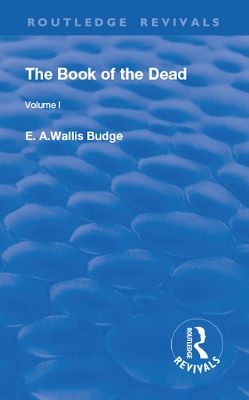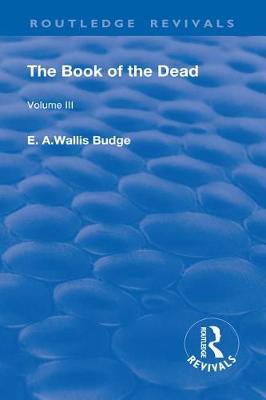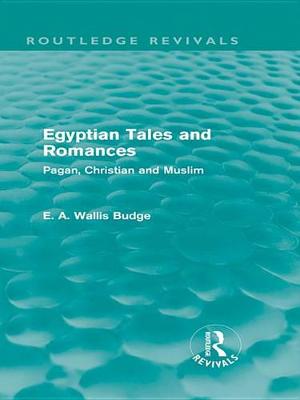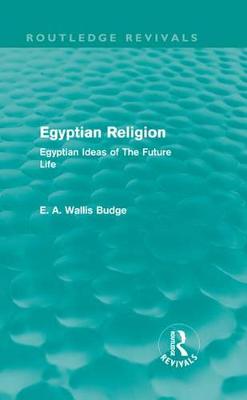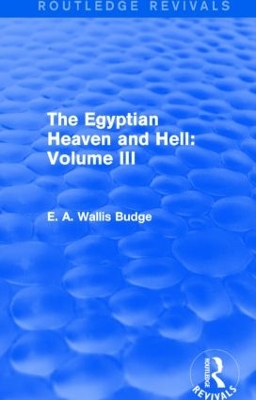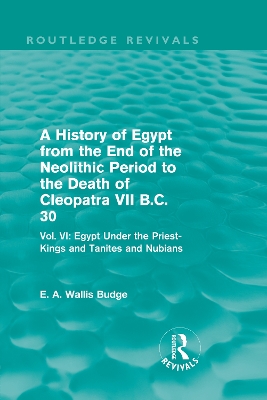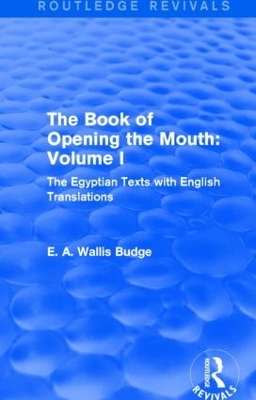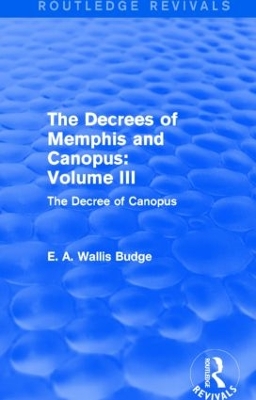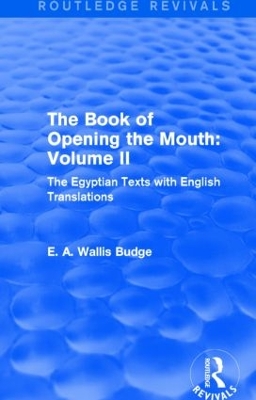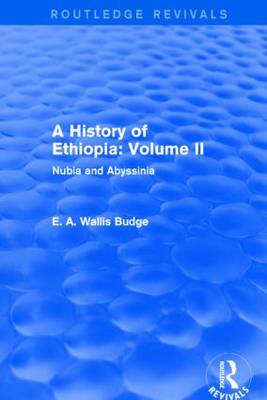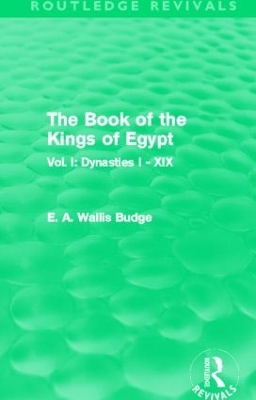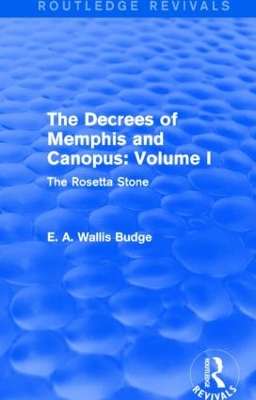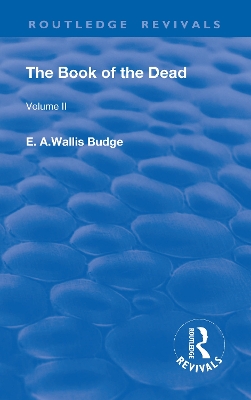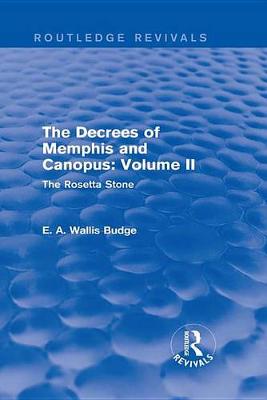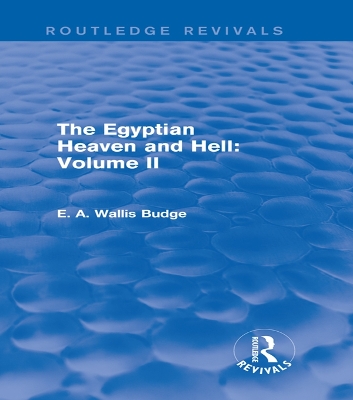Routledge Revivals
22 total works
E. A. Wallis translated and transcribed this work. The Book of the Dead is the name given by the ancient Egyptian funeral text 'The Book of Coming '[or 'Going']' Forth By Day'.
The book details the Egyptian view of the afterlife. Included are spells, hymns and instructions for the dead to pass through obstacles in the afterlife. This papyrus scroll was placed in the coffin of the deceased. The Book of the Dead was first thought to be a Bible but is it not a religious work. It is an instruction manual for the recently departed.
E. A. Wallis translated and transcribed this work. The Book of the Dead is the name given by the ancient Egyptian funeral text 'The Book of Coming '[or 'Going']' Forth By Day'.
The book details the Egyptian view of the afterlife. Included are spells, hymns and instructions for the dead to pass through obstacles in the afterlife. This papyrus scroll was placed in the coffin of the deceased. The Book of the Dead was first thought to be a Bible but is it not a religious work. It is an instruction manual for the recently departed.
E. A. Wallis translated and transcribed this work. The Book of the Dead is the name given by the ancient Egyptian funeral text 'The Book of Coming '[or 'Going']' Forth By Day'. The book details the Egyptian view of the afterlife.
Included are spells, hymns and instructions for the dead to pass through obstacles in the afterlife. This papyrus scroll was placed in the coffin of the deceased. The Book of the Dead was first thought to be a Bible but is it not a religious work. It is more of an instruction manual for the recently departed.
E. A. Wallis translated and transcribed this work. The Book of the Dead is the name given by the ancient Egyptian funeral text 'The Book of Coming '[or 'Going']' Forth By Day'. The book details the Egyptian view of the afterlife.
Included are spells, hymns and instructions for the dead to pass through obstacles in the afterlife. This papyrus scroll was placed in the coffin of the deceased. The Book of the Dead was first thought to be a Bible but is it not a religious work. It is more of an instruction manual for the recently departed.
Sir E. A. Wallis Budge (1857-1934) was Keeper of the British Museum's department of oriental antiquities from 1894 until his retirement in 1924. Carrying out many missions to Egypt in search of ancient objects, Budge was hugely successful in collecting papyri, statues and other artefacts for the trustees of the British Museum: numbering into the thousands and of great cultural and historical significance. Budge published well over 100 monographs, which shaped the development of future scholarship and are still of great academic value today, dealing with subjects such as Egyptian religion, history and literature.
First published in 1931, Egyptian Tales and Romances examines the historical and religious romances of the Egyptians from the early dynastic period to the twentieth century. Budge demonstrates Egypt's transition from Paganism to Christianity, and finally to Islam, through tales and stories carefully transcribed and translated. Part I contains historical romances written on papyrus and stone, whilst parts II and III are derived largely from Coptic and Muslim manuscript sources. Including detailed illustrations and photographs, this fascinating classic work will be of interest to academics and students of Egyptian folklore, archaeology and history, as well as the general inquisitive reader.
Sir E. A. Wallis Budge (1857-1934) was Keeper of the British Museum's department of oriental antiquities from 1894 until his retirement in 1924. Carrying out many missions to Egypt in search of ancient objects, Budge was hugely successful in collecting papyri, statues and other artefacts for the trustees of the British Museum: numbering into the thousands and of great cultural and historical significance. Budge published well over 100 monographs, which shaped the development of future scholarship and are still of great academic value today, dealing with subjects such as Egyptian religion, history and literature.
First published in 1899 as part of the Egypt and Chaldaea series, Egyptian Religion explores the principal ideas and beliefs held by the ancient Egyptians with regard to the doctrine of the resurrection and the future life. Although no systematic account dealing solely with this doctrine has been discovered, the Book of the Dead and various other religious texts from which this work is derived reflect ancient Egyptian beliefs, ideals and superstitions. Wallis Budge explores the Gods of the Egyptians and the themes of resurrection and immorality in a classic work, of great significance to students and scholars with an interest in ancient Egyptian and Middle Eastern history and religion.
The Book of Opening the Mouth: Vol. I (Routledge Revivals)
by E. A. Wallis Budge
The recital of The Book of Opening the Mouth and the Liturgy of Funerary Offerings were in use among the Predynastic Egyptians of the later part of the Neolithic Period, before the art of writing had evolved, and continued to exercise a considerable influence on Egyptian religious literature until the time of Roman Empire. The ceremonies were believed to enable the spiritual elements of the deceased to continue their existence. The object of the formulae was the reconstitution of the body and the restoration to it of the heart-soul ('Ba').
This is the first volume of The Book of Opening the Mouth, first published in 1909, which is edited from three copies written in the nineteenth, twentieth and twenty-sixth Dynasties respectively. It is believed they describe faithfully the forms of the rites which originated among the indigenous inhabitants of the Nile Valley.
This, the first volume of Sir E. A. Wallis Budge's The History of Ethiopia: Nubia and Abyssinia, first published in 1928, presents an account of Ethiopian history from the earliest legendary and mythic records up until the death of King Lebna Dengel in 1540.
Using a vast range of sources - Greek and Roman reports, Biblical passages, Egyptian hieroglyphs, and Ethiopian chronicles - an enthralling narrative history is presented with clarity. This reissue will be of particular interest to students of Ancient Egyptian culture, religion and history.
The Egyptian Heaven and Hell: Volume III (Routledge Revivals)
by E. A. Wallis Budge
This is the third of three volumes, first published in 1906, which treat the Egyptian theology of the afterlife. The first volume contains the complete hieroglyphic text of the Book Am-Tuat, with translations and reproductions of all the illustrations; the second, the hieroglyphic text of the short form of the Am-Tuat and the Book of Gates. This volume explores the origin of the Books of the Other World, highlighting and comparing the most remarkable features, with prefatory remarks and a full index to the whole work.
The object of all the Books of the Other World was to provide the dead with a 'guide' or 'handbook,' containing a description of the regions through which their souls would have to pass on their way to the Kingdom of Osiris, and which would supply them with the words of power and magical names necessary for an unimpeded journey from this world to the next.
Sir E. A. Wallis Budge (1857-1934) was Keeper of the British Museum's department of oriental antiquities from 1894 until his retirement in 1924. Carrying out many missions to Egypt in search of ancient objects, Budge was hugely successful in collecting papyri, statues and other artefacts for the trustees of the British Museum: numbering into the thousands and of great cultural and historical significance. Budge published well over 100 monographs, which shaped the development of future scholarship and are still of great academic value today, dealing with subjects such as Egyptian religion, history and literature.
This volume, first published in 1902, is the sixth of eight volumes by Budge dealing with different periods in the history of Egypt. The narrative begins with the reign of Nes-ba-Tettet, the first king of the XXIst Dynasty, and ends with the third king of the XXVIth Dynasty, Psammetichus II. Covering the years 1100-600 B.C., Budge analyses how Egypt changed shape under the rule of different kings, and witnessed both decline in and consolidation of power at varying points. This rich and important period of Egyptian history is explored in a classic work of great value to those interested in Egyptology and archaeology.
The Book of Opening the Mouth: Vol. I (Routledge Revivals)
by E. A. Wallis Budge
The recital of The Book of Opening the Mouth and the Liturgy of Funerary Offerings were in use among the Predynastic Egyptians of the later part of the Neolithic Period, before the art of writing had evolved, and continued to exercise a considerable influence on Egyptian religious literature until the time of Roman Empire. The ceremonies were believed to enable the spiritual elements of the deceased to continue their existence. The object of the formulae was the reconstitution of the body and the restoration to it of the heart-soul ('Ba').
This is the first volume of The Book of Opening the Mouth, first published in 1909, which is edited from three copies written in the nineteenth, twentieth and twenty-sixth Dynasties respectively. It is believed they describe faithfully the forms of the rites which originated among the indigenous inhabitants of the Nile Valley.
The Decrees of Memphis and Canopus: Vol. III (Routledge Revivals)
by E. A. Wallis Budge
This is the third of three volumes exploring some of the most remarkable insights into Ancient Egypt to have come to light in modern times. The first two volumes deal with the Rosetta Stone, an outstanding archaeological discovery which has supplied the basis for Egyptian decipherment; the final volume explores the "Stele of Canopus", discovered in 1866.
The Decree inscribed on the Stele of Canopus was passed at a general Council of Egyptian priests, setting forth the good deeds of Ptolemy III, and enumerating the benefits that he and his wife Berenice had conferred upon Egypt. Yet, the real significance of the Stele is that, like the Rosetta Stone, the text is inscribed in Hieroglyphic, Greek and Demotic Egyptian.
First published in 1904, this reissue provides an accessible general introduction to this fascinating subject, particularly useful for the amateur enthusiast as well as undergraduate students.
The Book of the Opening of the Mouth: Vol. II (Routledge Revivals)
by E. A. Wallis Budge
The recital of The Book of Opening the Mouth and the Liturgy of Funerary Offerings were in use among the Predynastic Egyptians of the later part of the Neolithic Period, before the art of writing had evolved, and continued to exercise a considerable influence on Egyptian religious literature up until the time of Roman Empire. The ceremonies were believed to enable the spiritual elements of the deceased to continue their existence. The object of the formulae was the reconstitution of the body and the restoration to it of the heart-soul ('Ba').
This is the second volume of The Book of Opening the Mouth, first published in 1909, which is edited from three copies written in the nineteenth, twentieth and twenty-sixth Dynasties respectively. It is believed they describe faithfully the forms of the rites which originated among the primitive indigenous inhabitants of the Nile Valley.
The Egyptian Heaven and Hell: Volume I (Routledge Revivals)
by E. A. Wallis Budge
This is the first of three volumes, first published in 1906, which explore the Egyptian theology of the afterlife. It contains the complete hieroglyphic text of the Book Am-Tuat, with translations and reproductions of all the illustrations. This text, at least in the form that we have it, was produced by the priests of Amen-Ra at Thebes, with the intention of demonstrating that their god was the overlord of all the gods, and the supreme power in the universe.
The object of all the Books of the Other World was to provide the dead with a 'guide' or 'handbook,' containing a description of the regions through which their souls would have to pass on their way to the Kingdom of Osiris, and which would supply them with the words of power and magical names necessary for an unimpeded journey from this world to the next.
This is the second volume of Sir E. A. Wallis Budge's narrative account of Ethiopian history, and continues the chronicle of the Kings of Abyssinia where the first volume ended: the death of Lebna Dengel in 1540.
The list of kings ends with the Regent Ras Tafari, who still reigned at the time of first publication in 1928. Thereafter, the author devotes considerable attention to an overview of the cultural, social and political idiosyncrasies of the Ethiopian people: literature, spells and magic, architecture, ethnography, the alphabet, and a wide range of other engrossing topics. This material complements the narrative history, helping to situate the deeds of the kings and the fortunes of their people in a broader context.
The Book of the Kings of Egypt (Routledge Revivals)
by E. A. Wallis Budge
Sir E. A. Wallis Budge (1857-1934) was Keeper of the British Museum's department of oriental antiquities from 1894 until his retirement in 1924. Carrying out many missions to Egypt in search of ancient objects, Budge was hugely successful in collecting papyri, statues and other artefacts for the trustees of the British Museum: numbering into the thousands and of great cultural and historical significance. Budge published well over 100 monographs, which shaped the development of future scholarship and are still of great academic value today, dealing with subjects such as Egyptian religion, history and literature.
First published in 1908, this is the first of two volumes dealing with the kings of Egypt. Using a variety of material from the British Library's extensive collections, Budge meticulously collated the names of the Pharaohs and royal personages from the 1st to the 19th Dynasties of Egypt. With a detailed discussion concerning Egyptian chronology, this classic work will be of great interest and value to scholars and students of Ancient Egyptian history and archaeology.
The Decrees of Memphis and Canopus: Vol. I (Routledge Revivals)
by E. A. Wallis Budge
This is the first of three volumes exploring some of the most remarkable insights into Ancient Egypt to have come to light in modern times. The first two volumes deal with the Rosetta Stone, an outstanding archaeological discovery that has supplied the basis for Egyptian decipherment; the final volume explores the "Stele of Canopus", discovered in 1866.
The significance of the Rosetta Stone lies in the three different languages that are inscribed onto it: Koine Greek, Demotic Egyptian, and, crucially, Hieroglyphic. This has facilitated a vast increase in our understanding of the sacred language of Ancient Egypt, as well as enhancing our understanding of the nature of kingship at a time of immense cultural transformation.
First published in 1904, this reissue provides an accessible general introduction to this fascinating subject, useful for the amateur enthusiast as well as undergraduate students.
E. A. Wallis translated and transcribed this work. The Book of the Dead is the name given by the ancient Egyptian funeral text 'The Book of Coming '[or 'Going']' Forth By Day'. The book details the Egyptian view of the afterlife.
Included are spells, hymns and instructions for the dead to pass through obstacles in the afterlife. This papyrus scroll was placed in the coffin of the deceased. The Book of the Dead was first thought to be a Bible but is it not a religious work. It is an instruction manual for the recently departed.
The Decrees of Memphis and Canopus: Vol. II (Routledge Revivals)
by E. A. Wallis Budge
This is the second of three volumes exploring some of the most remarkable insights into Ancient Egypt to have come to light in modern times. The first two volumes deal with the Rosetta Stone, an outstanding archaeological discovery which has supplied the basis for Egyptian decipherment; the final volume explores the "Stele of Canopus", discovered in 1866.
The significance of the Rosetta Stone lies in the three different languages inscribed on it: Koine Greek, Demotic Egyptian, and, crucially, Hieroglyphic. This has facilitated a vast increase in our understanding of the sacred language of Ancient Egypt, as well as enhancing our understanding of the nature of kingship at a time of immense cultural transformation.
First published in 1904, this title provides an accessible general introduction to this fascinating subject, useful for the amateur enthusiast as well as undergraduate students.
The Egyptian Heaven and Hell: Volume II (Routledge Revivals)
by E. A. Wallis Budge
This is the second of three volumes, first published in 1906, which explore the Egyptian theology of the afterlife. It contains the complete hieroglyphic text of the short form of the Am-Tuat and of the Book of Gates, with translations and reproductions of all the illustrations. In the Book of Gates the doctrines of the sophisticated cult of Osiris are prominent: they affirm that the beatified live for ever in the kingdom of Osiris, and feed daily upon his eternal body.
The object of all the Books of the Other World was to provide the dead with a 'guide' or 'handbook,' containing a description of the regions through which their souls would have to pass on their way to the Kingdom of Osiris, and which would supply them with the words of power and magical names necessary for an unimpeded journey from this world to the next.
